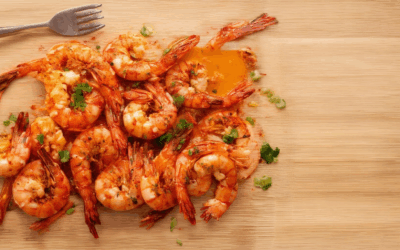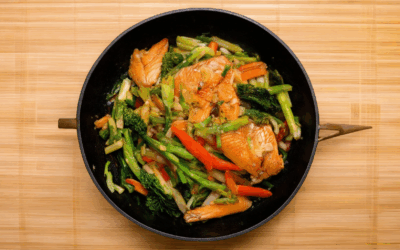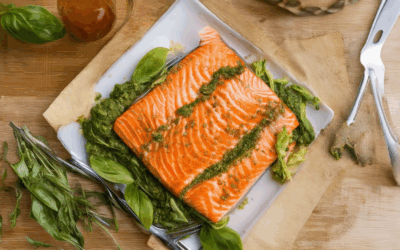Shrimp stir-fries are a beloved dish across the globe, combining the delicate flavor of shrimp with a vibrant array of vegetables for a nutritious and satisfying meal. Whether you’re a seasoned cook or new to the kitchen, crafting a perfect shrimp stir-fry with vegetables requires the right ingredients and techniques to ensure a balanced dish. From selecting the best vegetables to mastering the art of quick cooking, this guide explores everything you need to know to create a flavorful and healthy shrimp stir-fry. Discover the secrets to achieving a restaurant-quality meal at home, including tips on enhancing your dish with peanut sauce or exploring authentic Thai and Chinese flavors. Learn how to avoid common mistakes and make the most out of your ingredients, ensuring your shrimp stir-fry is both competition-free and packed with taste. With the right approach, your shrimp stir-fry with vegetables will be a hit every time, whether served over rice, noodles, or simply on its own. This comprehensive guide covers all the bases, from essential ingredients to expert cooking techniques, providing you with the knowledge to create a truly impressive dish.
Key Takeaways
– Master Shrimp Stir-Fry Technique: Avoid common mistakes like overcooking, using the wrong oils, and overcrowding the pan to achieve perfectly cooked shrimp.
– Enhance Flavor and Texture: Soak shrimp in milk before frying to tenderize, manage moisture, and add depth to their flavor.
– Follow Stir-Frying Rules: Use high heat, avoid overcrowding, and add sauce gradually for crispy, flavorful results.
– Experiment with Ingredients: Try various proteins and vegetables to keep your shrimp stir-fry recipes exciting and nutritious.

Vegetables That Pair Well with Shrimp
Shrimp is a versatile ingredient that can be paired with a variety of vegetables to create delicious and nutritious meals. Here are some excellent vegetable choices that complement shrimp:
- Bell Peppers : Known for their vibrant color and mild flavor, bell peppers add a satisfying crunch and enhance the dish’s visual appeal.
- Zucchini : This neutral-tasting vegetable absorbs flavors well and adds a subtle sweetness to shrimp dishes.
- Carrots : Their natural sweetness balances the saltiness of shrimp, making them a great addition to stir-fries and salads.
- Broccoli : With its crunchy texture and earthy flavor, broccoli stands out in dishes like stir-fries and pasta.
- Peas : Sweet and tender, peas are a delightful addition to shrimp recipes, particularly in soups and stir-fries.
- Bok Choy : Similar to cabbage, bok choy has a crisp texture and mild flavor, perfect for stir-frying with shrimp.
- Asparagus : Its slight bitterness contrasts beautifully with the briny taste of shrimp, making it a unique addition.
- Cherry Tomatoes : Fresh and juicy, cherry tomatoes add a burst of acidity and a refreshing element to shrimp dishes.
- Spinach : A mild green, spinach adds freshness and nutrients, working well in both raw dishes and cooked ones.
- Arugula : Known for its peppery flavor, arugula adds a spicy kick that pairs nicely with shrimp.
These vegetables not only enhance the taste of shrimp but also provide a variety of textures and nutritional benefits. Whether you’re grilling, stir-frying, or creating a salad, these options offer versatility and depth to your dishes.
The Secret to Perfect Stir-Fried Vegetables
Stir-frying is an art form that requires precision and patience. Here’s how to master it:
Key Secrets to Successful Stir-Frying
- Timing is Everything: Cook vegetables in batches. Overcrowding the pan leads to steaming, not stir-frying. Leave space for movement.
- Use the Right Oil: A high smoke point oil like vegetable oil or sesame oil is ideal. Avoid olive oil as it burns easily.
- Don’t Stir Too Much: Stir only when necessary. Let the vegetables sear slightly before stirring to develop flavor.
- Know Your Veggie Order: Start with harder vegetables like broccoli and carrots, then add softer ones like bell peppers and snap peas.
- Season Wisely: Add salt, pepper, and spices early. Toss in garlic and ginger towards the end to prevent burning.
- Serving Suggestions: Serve over rice, noodles, or as a standalone dish. Garnish with herbs like cilantro for freshness.
Perfect Stir-Fry Recipe Guide
- Heat a large skillet or wok over medium-high heat.
- Add a few tablespoons of vegetable oil. Wait until it smokes slightly.
- Throw in your first batch of vegetables (harder ones first). Stir-fry for 2-3 minutes.
- Add a bit of water or broth if needed. Cook until tender-crisp.
- Push vegetables to one side, add protein or sauce, and combine everything evenly.
- Taste and adjust seasoning. Serve immediately!
Master these techniques, and you’ll achieve crispy-tender, flavorful vegetables every time. For more stir-fry inspiration, check out our complete collection of stir-fry recipes .

What Goes In A Shrimp Stir Fry?
- Base Ingredients:
- Garlic
- Ginger
- Soy sauce
- Oyster sauce (optional)
- Rice wine or sherry (optional)
- Cornstarch (for thickening)
- Proteins:
- Shrimp
- Chicken (optional)
- Tofu (optional)
- Vegetables:
- Broccoli
- Bell peppers
- Carrots
- Snap peas
- Mushrooms
- Optional Additions:
- Chili flakes or red pepper (for heat)
- Sesame oil (for aroma)
- Green onions or chives (for garnish)
- Additional vegetables (like zucchini or bean sprouts)
- Tofu or extra protein

Common Mistakes When Stir-Frying Shrimp
Stir-frying shrimp can be a delicious and quick dish, but many home cooks make common mistakes that can lead to suboptimal results. Here are some key errors to avoid:
- Overcooking the Shrimp: Shrimp cook quickly, typically taking about 1-2 minutes on each side. Overcooking will make them tough and rubbery.
- Using the Wrong Oil: Stir-frying requires high heat, so use a neutral oil like vegetable oil or sesame oil. Avoid olive oil, as it can burn at high temperatures.
- Not Sautéing Aromatics Properly: Always stir-fry garlic and ginger first before adding shrimp. This ensures flavors are released and enhances the dish.
- Overcrowding the Pan: Too many ingredients in the pan can cause steaming instead of searing. Keep space for movement and avoid overcrowding.
- Adding Too Much Liquid: Stir-fries are dry dishes. Excess liquid can dilute flavors and make the texture mushy.
- Not Using High Heat: Stir-frying requires constant high heat to seal the shrimp and cook them quickly. Low heat can result in uneven cooking.
- Ignoring the Shrimp’s Curvature: Shrimp curve naturally; cook them curved side down to ensure they cook evenly and don’t become rubbery.
- Underseasoning: Don’t skimp on seasoning. A balance of salt, pepper, and optionally chili flakes or garlic powder is essential for flavor.
- Not Stirring Enough: Constant stirring ensures even cooking and prevents sticking. Stir frequently but gently to avoid breaking the shrimp.
By avoiding these mistakes, you can achieve perfectly cooked, flavorful shrimp every time. Practice proper technique and enjoy your stir-fried shrimp dishes!
Why Soak Shrimp in Milk Before Frying?
Shrimp soaked in milk before frying benefit from several factors that enhance both taste and texture:
- Tenderization : The mild acids in milk help break down the proteins and connective tissues in the shrimp, making them softer and more tender. This process reduces the chewiness often associated with fried shrimp.
- Moisture Management : By absorbing excess moisture, milk prevents the shrimp from splattering in the fryer and ensures a crispy exterior without greasiness.
- Flavor Enhancement : The slight tanginess of milk complements the natural sweetness of shrimp, adding depth to their flavor while preventing them from tasting too bland.
This method results in shrimp that are juicy, flavorful, and perfectly cooked every time.

What Are the Three Rules of Stir-Frying?
Stir-frying is a versatile cooking method that combines quickly-cooked vegetables and proteins in a wok or skillet. To master this technique, follow these essential rules:
- Use High Heat:** Stir-frying requires high heat to sear ingredients quickly, which brings out their flavors and helps prevent sticking.
- Don’t Overload the Pan:** Cook small batches of food to avoid overcrowding, which can lead to uneven cooking and steaming instead of stir-frying.
- Add Sauce Gradually:** Pour in a little sauce at a time, allowing the ingredients to brown before coating them evenly. This ensures a flavorful finish without mushy textures.
By following these rules, you can create delicious and crispy stir-fried dishes every time. Experiment with different proteins and vegetables to keep your meals exciting!




0 Comments